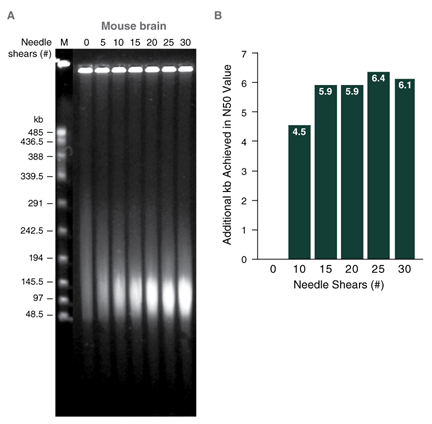Homogenization of High Molecular Weight DNA (HMW DNA) Samples After Elution
General Approaches
Pipetting with Wide Bore Tips
When the DNA is eluted from the beads, the bulk phase retains the wrapped conformation it had when attached to the bead. Pipetting up and down with a 200 µl wide bore pipet tip breaks this conformation and facilitates dissolving and dispersion.
Heat
Heat will reduce the viscosity of the solution and significantly increase the speed of homogenization of HMW DNA solutions. Below are some additional guidelines when using heat:
- Temperatures > 60°C are generally not recommended as they will lead to DNA denaturation and degradation.
- Incubation at 56°C, the temperature used for elution, is appropriate only for short incubation times. Do not exceed 30 minutes.
- Samples can be incubated at 37°C for several hours safely; DNA integrity will not be affected.
- Incubation at room temperature overnight facilitates even homogenization of the DNA.
- Incubation at 4°C for days or weeks also facilitates homogenization and relaxation of HMW DNA.
If samples are incubated at 37°C for homogenization, mixing the samples at low agitation speed (300 rpm) will increase homogenization efficiency.
Time
HMW gDNA needs time to relax and homogenize. It is generally not recommended to work with freshly eluted DNA unless significant effort is made to ensure even DNA resuspension. Allowing the sample to relax overnight, or for several days, facilitates homogenization. If possible, it is recommended that UHMW DNA is extracted several days or a week prior to being needed for downstream applications.
Dilution
HMW gDNA should ideally be kept at a concentration of 100–200 ng/µl for easy handling and reliable analysis. As such, using 200 µl elution buffer is recommended for samples obtained from > 2 x 106 cells, > 500 µl mammalian blood or > 5 µl nucleated blood. The viscosity of the DNA solutions decreases significantly with dilution. After dilution, samples will require additional homogenization by the procedures described below.
For Samples Agitated at Maximum Speed
When agitation is carried out at 2000 rpm during lysis, purified DNA solutions should be only moderately viscous. In order to homogenize these samples prior to downstream analysis or use, the following steps are recommended:
- After elution, pipette up and down 5–10 times using a 200 µl wide bore pipette; ensure any clumps of DNA are dispersed.
- Incubate DNA samples for 30–60 minutes at 37°C.
- Pipette up and down 5–10 times again using a wide bore pipette tip.
- (Optional) Briefly vortex; short vortexing will not affect overall DNA size.
For Samples Agitated at Low Speeds (UHMW DNA)
Samples isolated following agitation with low speeds are extremely viscous and require additional effort to relax and homogenize before analysis and use. When homogenized completely, samples will appear consistent throughout the tube and OD measurements will become more consistent. The following steps are recommended:
- After elution, pipette up and down 5–10 times using a 200 µl wide bore pipette; ensure any clumps of DNA are dispersed.
- Incubate DNA samples for 30–60 minutes at 37°C.
- Pipette up and down 5–10 times again using the same wide bore pipette tip.
- Repeat 1–2 times each day for at least 2 days.

Related Products:
Related Resources:
- Monarch HMW DNA Extraction Kit for Cells & Blood Product Manual
- Monarch HMW DNA Extraction Kit for Tissue Product Manual
- Measuring, Analyzing & Storing High Molecular Weight DNA (HMW DNA) Samples
- Considerations and Performance Data for Nanopore Sequencing of High Molecular Weight DNA (HMW DNA)
- Troubleshooting Guide for High Molecular Weight DNA Extraction Using the Monarch HMW DNA Extraction Kits
- Ultra-Long DNA Sequencing Workflow®Guidance for HMW DNA Extraction Upstream of Oxford Nanopore Technologies
- Protocol for UHMW DNA Cleanup in the Oxford Nanopore Technologies® UL Library Prep Workflow

